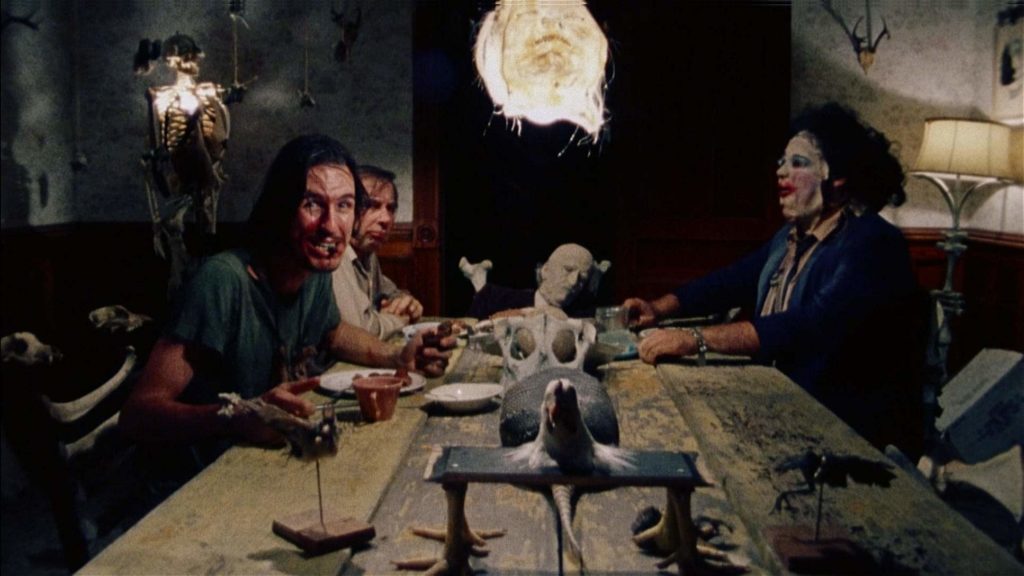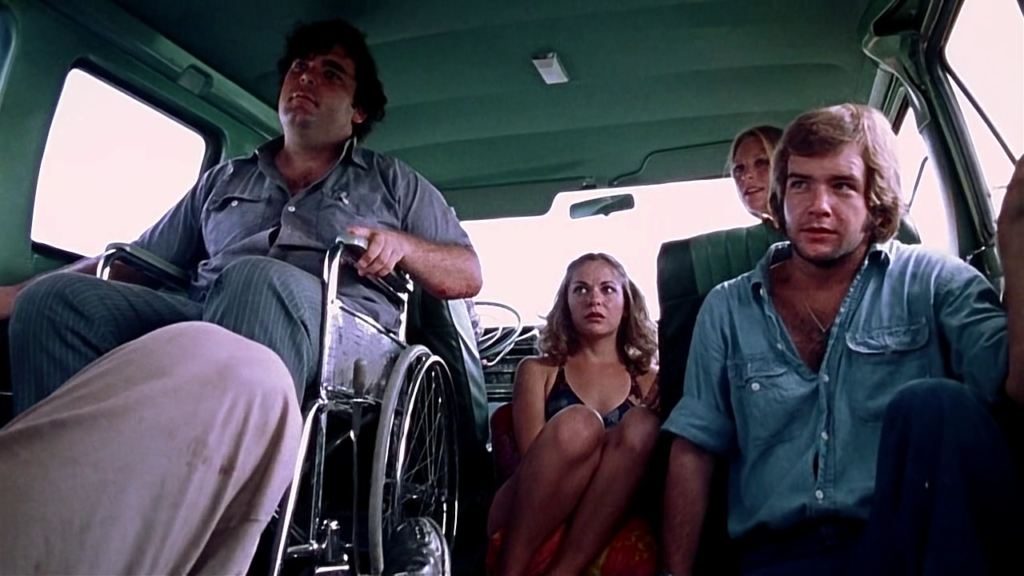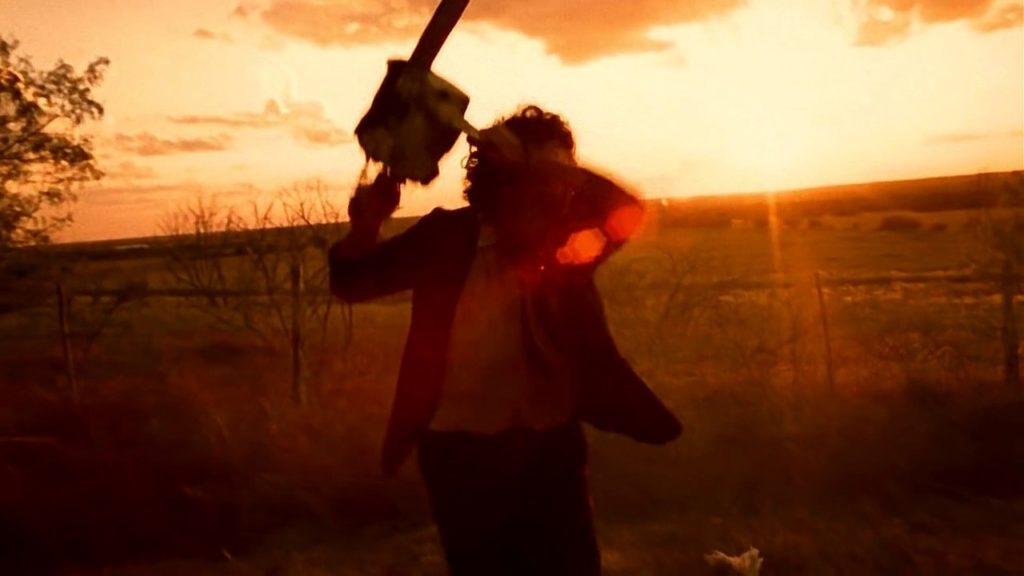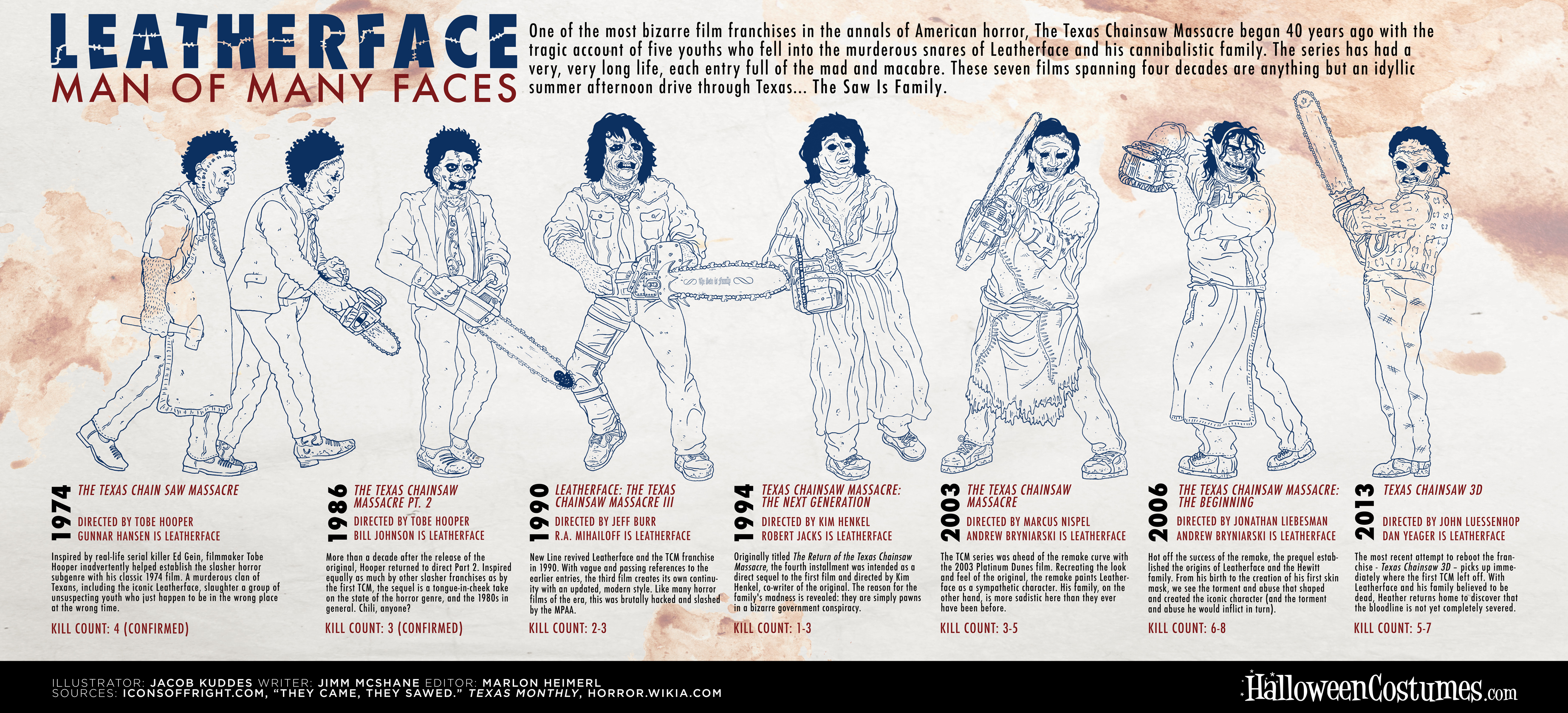That’s just the first five minutes. The rest of the movie involves a slow, measured descent into the madness of the Sawyer family, and culminates in a final ten minutes of torture and terror, largely round the dinner table. Domestic violence gets extreme.

The premise is simple. A Scooby Doo-esque van of longhairs (Jerry, Kirk, wheelchair bound Franklin, his sister Sally and bare-backed, micro-shorted Pam) goes to investigate the aforementioned graverobbings to see if Grandfather has been affected. He hasn’t. On the way home they start to ignore some dire warnings in the astrology magazines that Pam is set on believing. Franklin’s horoscope predicts “a difficult and disturbing day” whilst Sally’s reveals that “There are moments when we cannot believe what is happening is really true. Pinch yourself and you may find out that it is”. Other warnings come from the more traditional horror genre source of a mad old drunk in the cemetery (“Things happen hereabout they’ll tell about”) and the gas station attendant (“You boys don’t wanna go messing round no old house. Those things is dangerous, you’re liable to get hurt.”) but all are ignored. When the gas station is out of gas, the hapless hippies fill up on barbecue instead and decide to hang out at the old house until the fuel truck arrives to make a delivery. A fatal choice.

They are trespassers, and, since the slaughterhouse down the road upgraded to more humane methods of killing, there are four rightfully resident Sawyers itching to smash their sledgehammers on the skulls of fresh meat. This sequestered clan are truly grotesque – the gibbering Hitchhiker, the half-decayed Grandfather, the slobbering Cook and of course, Leatherface – and they represent that stubborn, isolationist streak in American backwoodsmen who simply like to live the way they live, and don’t want to be answerable to anyone. They’ll defend their lifestyle to the death, even if it involves decorating neighbouring homes with chicken bones, and despatching nosey strangers, hence the number of abandoned cars discovered by Pam and Kirk as they explore the farmyard.
For a movie that was banned outright for 20 years in the UK, there is remarkably little gore. Almost halfway through the taut 84 minutes run time, all the blood we have really seen has been oozing from the palm of the Hitchhiker. When Kirk runs foul of Leatherface his despatch is famously speedy, two quick blows with a sledgehammer. Pam’s demise is more drawn out, but bloodless – Hooper was aiming for a PG rating and was careful not to show the meathook entering her skin. The audience’s over-wrought imaginations have to do the work, here and with the deaths of Jerry and Franklin, which both occur offscreen.
The monster here is towering figure of Leatherface, otherwise known as Bubba Sawyer, played (in this instalment) by 6’4″ Icelander Gunnar Hansen. Bubba never speaks, never reveals his motives, just flails his hammer or cranks up his chainsaw, his face hidden behind one of three masks stitched from the skin of previous victims. His menace is evocative through its simplicity; he lacks the complex motivation of Norman Bates or Michael Myers, he simply is what he is, as his final joyous dance with the chainsaw attests.

Sally Hardesty is the sole survivor of his blade, an early example of the genre trope, the Final Girl. Her torture at the hands of each one of the Sawyer family is the movie’s only real nod to excess. She appears to be experiencing punishment for some ambiguous travesty (a sibling spat with crippled Franklin? implied sex with Jerry upstairs in the old Franklin house?), as she is first chased through the woods by Leatherface (her long hair gets tangled in thorn bushes and nearly leads to her capture, perhaps her sin is vanity?), then stuffed in a sack by the Cook, shackled to a skeleton-chair by the Hitch-hiker, and finally served up as Grandpa’s hors d’oeuvres.
For much of this she screams, relentlessly, is covered in blood, and appears to act without much forethought, leaping through an upstairs (and closed) window. In terms of spectatorship, the audience cannot empathise for long with this extreme and unrelenting state. Instead they distance themselves from her demented semi-nakedness, and begin to view her with the killer’s impassivity. Her eventual escape is not a represented as a looked-for triumph, far from it. She does not overcome the monster as her Final Sisters would increasingly manage to do in the 1980s and 1990s, but loses her essential self to him. There is only one character dancing with joy in the sunrise at the end of this movie.
Hooper’s initial envisioning of the film required plenty of handheld shots, cinema verité style, but he couldn’t rent a lightweight enough 35mm camera – hence the decision to shoot in 16mm. The resultant low budget aesthetic – grain, inconsistent colours, a fly-blown feeling to every frame – adds to the backwoods ethos. There is nothing glossy or civilised about this narrative, it all happens on the fringes of the known world, but the tone is emphatically realistic, from the poster declaration that it is “inspired by a true story” to the opening title which refers to “one of the most bizarre crimes in the annals of American history” and gives a specific date to events, 18th August 1973. The documentary feel extends the work done by Romero in Night of The Living Dead, and was much copied by subsequent low budget entries to the genre.
Sequels
Even today, TCM seems brutal, in a way that none of its sequels quite manage —but if a story idea ain’t broke, don’t fix it. The Texas Chain Saw Massacre has a surprisingly robust track record as intellectual property, and to date, there have been eight movies, a comic book series, and a video game based on Leatherface and friends. For the record, the sequels, reboots and remakes are:
The Texas Chainsaw Massacre 2 (1986)
Takes place 13 years after the events of the original movie, as Leatherface attacks a couple of obnoxious high school seniors, unaware that his chainsaw sweeps are being recorded, and that the recording will be broadcast on the radio, triggering terror across Texas. Aided by SFX guru Tom Savini, director Tobe Hooper went for a comedy horror feel, playing to Leatherface’s strengths as an icon to rival new kid on the mid-80s block, Freddy Krueger. Stars Dennis Hopper and Caroline Williams, with Bill Johnson taking on the role of Leatherface.
Leatherface: The Texas Chainsaw Massacre 3 (1990)
Technically a reboot, as if Leatherface (this time played by R.A. Mihailoff) didn’t die at the end of TCM2, but also framed as a direct sequel to TCM1. We’re introduced to more of the Sawyer family (who share Leatherface’s fondness for murder by power tool), and a young Viggo Mortensen can be seen as hitchhiking cowboy, Tex.
Texas Chainsaw Massacre: The Next Generation (released 1994 and 1997)
Writer of the original, Kim Henkel picked up the reins again for this entry, described as both “a loose remake and quasi-sequel”. This time out, Robert Jacks plays Leatherface, preying on a group of teenagers stranded in rural Texas after a post-prom car wreck. It stars a then-unknown Matthew McConaghey and Renée Zelleweger, and was re-released in 1997 to take advantage of their burgeoning fame.
The Texas Chainsaw Massacre (2003)
Michael Bay’s Platinum Dunes pushed this remake onto a largely unappreciative market (although it did over $100M box office business). Despite having Tobe Hooper and Kim Henkel on board as co-producers, it’s straightforward and rather humorless, retelling the story of the original, changing the Sawyers into Hewitts and presenting former bodybuilder Andrew Bryniarski as Leatherface. Jessica Biel and Andrew Vogel are among the hapless teens fleeing his whirring blade.
The Texas Chainsaw Massacre: The Beginning (2006)
This entry traces Leatherface’s (for once, the role is reprised, by Andrew Bryniarski) origins back to a grim Texas slaughterhouse in the 1930s, where his mother dies giving birth at her workplace. Her boss leaves the infant in a charnel dumpster, for dead, but local crazylady Luda Mae Hewitt pulls him out and takes him home. After this promising start (could there be an original story peeking through?), this entry reverts all too quickly to the formula, flashing forward to 1969 when a group of hapless hippy teenagers (including Jordana Brewster) wreck their car on the wrong rural road.
3-D Texas Chainsaw Massacre (2013)
The Hewitt episode apparently forgotten, we’re back to the Sawyers. A distant cousin, Heather, inherits the house from her grandmother, and turns up to claim her inheritance, along with three friends and a greedy hitchhiker, Darryl. Leatherface (this time, Dan Yeager) is ready and waiting. After a few scuffles involving his chainsaw and her erstwhile companions, Leatherface and Heather realize that family is the only thing that counts, and settle down together to live the bucolic Sawyer dream.
Leatherface (2017)
In keeping with the 2010s obsession with origin stories, this entry jumps back in time to the 1950s when a young child is taken away from his crazy backwoods family and raised in an institution. He develops normally – until a riot breaks open the only home he’s ever known. The story of this movie’s journey to the screen is way more complicated than the plot itself. Starring Stephen Dorff and Lili Taylor.

Infographic Created by HalloweenCostumes.com